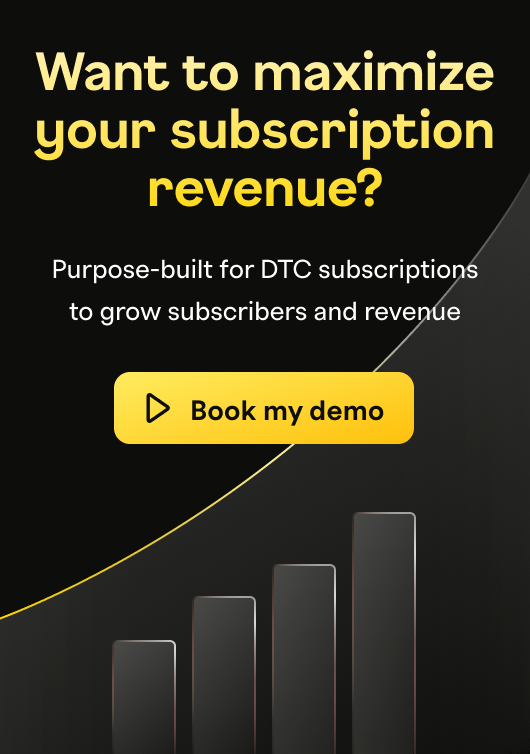Key takeaways from 2025 State of Subscriptions: Industry benchmarks & trends

In a riveting panel discussion focused on the 2025 State of Subscriptions report, leaders from Codecademy, Chegg, Lucidchart, and Recurly shared their wisdom on the rapidly changing landscape of the subscription industry. From grappling with lowering acquisition rates to balancing customer retention—the session provided a comprehensive view of the current state of the subscription economy and shifts to come in the coming months.
Speakers included:
Avi Sharma, Senior Product Manager (Growth), Codecademy
Steve Wellman, Sr. Director of Billing & Payments, Lucidchart
Bryan Gregory, Director of Engineering, Chegg
Brian Geier, VP, Business Intelligence, Recurly
Mary Rosberg, VP Growth Evangelist, Recurly
Key subscription trends of 2025
Recurly kicked off the meeting of the minds with some exclusive findings from the 2025 State of Subscriptions report. The report highlights customer expectations, necessitating flexibility and personalization in subscriptions. Key data shows a drop in acquisition rates, decrease in trial conversion rates, and an increase in subscribers canceling and returning later, reflecting the ever-shifting relationship between customers and subscription companies.
Bridging the acquisition and retention gap
In the face of these evolving dynamics, our panelists shed light on their respective strategies and experiences. Avi Sharma, Senior Product Manager at Codecademy, shared his approach of focusing on improved user acquisition, enhanced retention, and increased revenue, doing so through methods such as:
Improved on-boarding experience
Targeted re-engagement campaigns
Surfacing relevant content and features to those on the platform
And more!
Bryan Gregory, Director Of Engineering at Chegg, emphasized understanding data to serve subscribers better. Steven Welland, Sr. Director of Billing & Payments at Lucidchart, spotlighted their efforts in optimizing payment workflows, enhancing customer experiences, and reducing renewal process friction.
All panelists highlighted the shift towards retention and the need to balance it with acquisition in their growth strategies. Data is extremely important in this regard. To effectively measure user engagement, it’s important to consider metrics tailored to the specific service. For instance, consumption patterns are key for product-based services, while time spent on the platform is more relevant for media subscription services.
Additionally, engagement strategies should be customized for different consumer cohorts to align with their unique preferences and behaviors, ensuring a more personalized and impactful approach.
Trials, payment methods, and promotions
Trials have traditionally helped convert potential customers, but with changing consumer behavior, they’re now more of an exploratory tool. Steve Wellman highlighted how there’s not only more competition, but an increased need for an immediate ROI, especially in the tech and software industries. This becomes even more complicated by growing use of one-time-use cards for trials, stressing the importance of understanding customer intentions.
Flexibility, personalization, and the future of subscriptions
Today’s customers demand more from their subscriptions. They expect flexible payment options, personalized plans, and a seamless experience. As Bryan Gregory highlights, subscription audiences have evolved—what worked five years ago won’t cut it today. If you want to keep your subscribers loyal, you need to deliver on their expectations. Flexibility, ease, and personalization aren’t optional—they’re how you win, year after year.
Because of this shift in the market, it’s highly important to start building trust with your subscribers as quickly as possible. You can’t wait for them to see your value. You have to prove it to them.
Re-engaging lapsed subscribers
Re-engagement of lapsed subscribers is not a one-size-fits-all approach. A thoughtful approach tailored to your industry and company will be essential. As Bryan Gregory points out, even some marketing materials can turn potential re-subscribers off of your service in the following clip. You need to be willing to experiment with different approaches and ideas. That may mean a combination of:
Coupons
Free trials
Product offerings
Bundled services
Upgrades
And more!
What the future holds
Regarding future trends, the panelist emphasized the need for tailored experiences, reducing friction during onboarding, prioritizing engagement, and providing elasticity in subscription management. Tokenization and alternative payment methods are also becoming an increasing path for companies to manage and battle fraud.
Ready to uncover the metrics that matter and chart your course for 2025?
Learn more about the new State of Subscriptions report and even more analysis with our latest virtual event, where you’ll discover exclusive benchmarks and trends that can help you grow and retain subscribers with ease.

Frequently asked questions
What additional alternative payment methods (APMs) are on the rise?
Recurly's data reveals that PayPal remains a significant player among alternative payment methods (APMs). However, the most notable growth from 2023 to 2024 has been seen in Apple Pay, which has experienced a dramatic surge in usage jumping from 0.6% to 1.8%. APMs are becoming increasingly popular due to their lower fraud rates compared to credit and debit cards, making them an emerging priority for merchants in the years ahead.
Does Recurly count paused subscriptions as churns? I.e. If no ARR is coming in from that customer, how do you report on them?
For Recurly, churn is measured at the subscriber level, not the subscription level. This distinction is important because a single subscriber can hold multiple subscriptions. Pauses, however, are tracked at the subscription level and are not counted as churn.
What has worked best in making the re-subscribe process “friction-free?”
The most effective strategies focus on reducing friction for customers, regardless of the channel they use. This includes features like a seamless "one-click to resubscribe" option within the app, made possible through lifecycle engagement tools.
How can you get acquisition teams onboard to also think about retention as part of their broader growth strategy?
To encourage acquisition teams to view retention as a key growth strategy, consider aligning incentives and incorporating retention into KPIs. One effective approach is to embed retention within overall growth objectives, helping acquisition teams see it as a multiplier for success rather than a separate responsibility.
How can Recurly assist in utilizing various customer engagement channels, such as in-app, push, SMS, and email, to effectively communicate and drive higher trial conversion rates? Can you provide specific examples of successful strategies?
Recurly's lifecycle management tool enables businesses to engage subscribers through channels like in-app messaging, push notifications, SMS, and email to boost trial conversions. Personalized, timely messages help guide users through the trial, address concerns, and highlight product value. For example, onboarding emails, push notifications about key features, or SMS reminders about trial expirations keep users engaged and encourage them to subscribe.
Want find out more about Recurly? Book your demo now.

